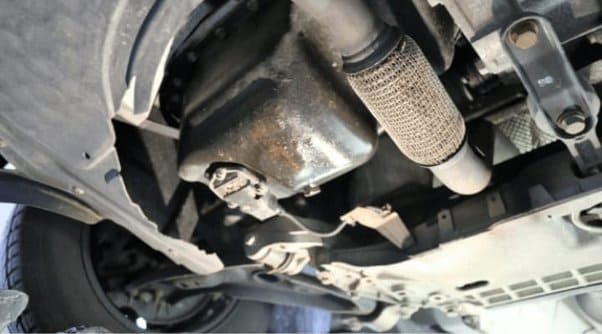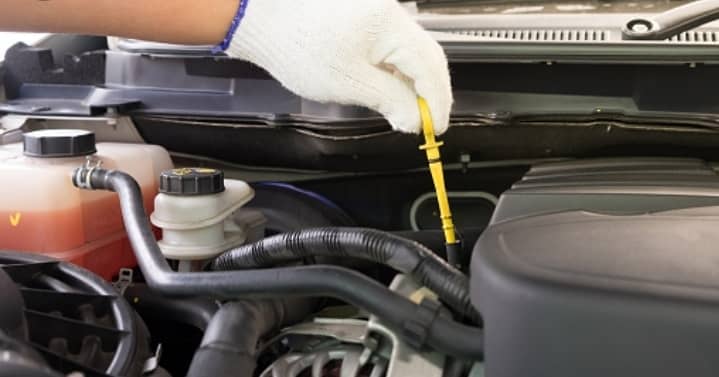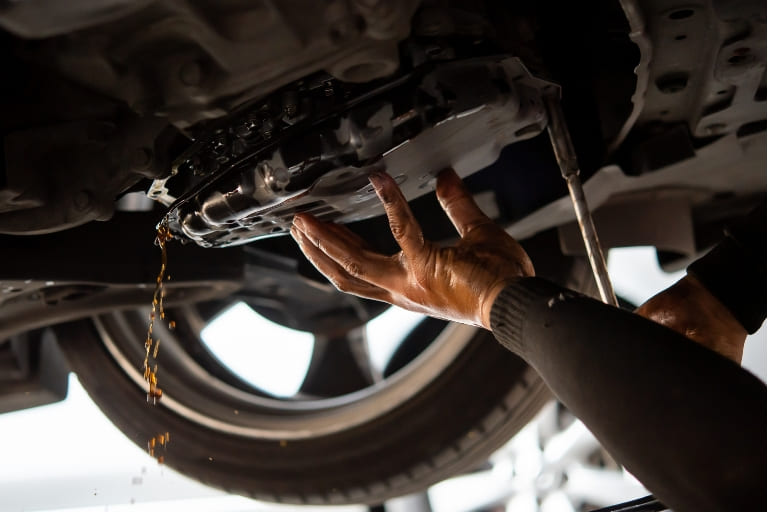Have you ever noticed a decrease in your transmission fluid level without any visible leaks? It was a difficult experience for me.
As a car owner, you must grasp the reasons and potential remedies to this problem.
This article will dive into the mystery of losing transmission fluid without a leak and explore various reasons for this phenomenon.
From worn-out seals to internal transmission issues, we’ll cover it all. So, don’t let this problem catch you off guard; keep reading to find out how to tackle it.
Contents
- 1 Can You Lose Transmission Fluid without A Leak?
- 2 Why Would Transmission Fluid Disappear Without Leak?
- 3 How to Prevent Transmission Fluid Loss without A Leak
- 3.1 Regularly Checking Transmission Fluid Levels
- 3.2 Scheduled Transmission Maintenance and Inspections
- 3.3 Fix Any Worn-Out or Damaged Seals and Gaskets.
- 3.4 Replace Faulty Vacuum Modulators.
- 3.5 Install a Transmission Cooler.
- 3.6 Regularly Check for Leaks and Address Them as Soon as Possible.
- 3.7 Seek Professional Help If you Are Losing Transmission Fluid Without a Leak
- 4 Conclusion
Can You Lose Transmission Fluid without A Leak?

No, you cannot lose transmission fluid without a leak. Transmission fluid is a hydraulic fluid used to lubricate and cool the transmission. It is not flammable and does not evaporate, so it cannot simply disappear. If you are losing transmission fluid, there is a leak in the system.
Some common circumstances where you can lose transmission fluid:
- Overfilling the transmission: When the transmission is overfilled, the excess fluid can be forced out of the vent or overflow tube.
- Faulty transmission seals: If the seals on the transmission are worn or damaged, they may not correctly contain the fluid, causing it to leak out.
- Cracked or punctured transmission pan: If the transmission pan is cracked or punctured, fluid can leak out.
- A faulty vacuum modulator: A vacuum modulator controls the transmission’s shifting. If it’s faulty, it can cause the transmission to overheat, which can cause the fluid to expand and be forced out of the dipstick tube or overflow hose.
- Worn or damaged transmission components: The gears and bearings inside the transmission can wear down over time, causing the transmission to lose fluid.
- Low transmission fluid level in a continuously variable transmission (CVT) can also cause overheating or gear slipping, which causes the fluid to lose.
These are some common examples, but there could also be other reasons. If you detect a fluid leak, have an expert examine the transmission.
Why Would Transmission Fluid Disappear Without Leak?
Evaporation Due to High Temperatures
High temperatures can induce transmission fluid to evaporate, resulting in fluid loss with no visible leak.
This can occur when the transmission is overheating or the vehicle is driven in scorching conditions.
Transmission fluid is designed to dissipate heat, but if the temperature gets too high, it can start to boil and evaporate. This can cause the fluid level to drop, leading to a loss of fluid without a visible leak.
To prevent evaporation from high temperatures, it’s essential to ensure the transmission is not overheating. This can be done by regularly checking the transmission fluid temperature and ensuring it’s within the normal range.
If the temperature is too high, it could indicate a problem with the transmission cooling system, such as a clogged cooler or a malfunctioning fan.
It’s also essential to avoid driving in extreme heat or in stop-and-go traffic, which can cause the transmission to overheat.
Incorrect Level of Transmission Fluid

If the transmission fluid is not at the correct level, it can cause issues with the transmission, such as slipping gears and overheating. This can lead to fluid loss without a visible leak. It is vital to regularly check the transmission fluid level and top it off as needed to ensure the proper functioning of the transmission.
A low fluid level might force the gearbox to work harder than necessary, increasing wear and tear and overheating.
The automobile should be on a level surface, and the engine should be operated to check the transmission fluid level.
The transmission fluid level can be checked using the dipstick, which is usually located near the transmission. The fluid level on the dipstick should be between the two markers, showing that it is at the proper level. If the fluid level is low, it should be replenished with the proper transmission fluid.
It’s also important to note that a low fluid level can indicate a leak, so it’s essential to check for visible leaks and the fluid level.
Wear and Tear on The Transmission System
Over time, the transmission system can experience wear and tear, which can cause fluid loss without a visible leak. This can include worn or damaged gears, bearings, and seals. These issues can lead to small leaks or seepage that may not be visible but can still result in losing transmission fluid.
Wear and tear on the transmission system can be caused by various factors, including high mileage, lack of regular maintenance, and use of the transmission in abnormal conditions.
To prevent wear and tear on the transmission system, it’s essential to have regular transmission maintenance, such as fluid and filter changes, to ensure that the transmission is running at its best. It’s also crucial to avoid any abnormal use of the transmission, such as towing heavy loads or using the transmission in extreme conditions.
Bad Vacuum Modulator
A vacuum modulator controls the shifting of the transmission. If it’s faulty, it can cause the transmission to overheat, which can cause the fluid to expand and be forced out of the dipstick tube or overflow hose.
A faulty vacuum modulator can also cause the transmission to shift erratically, leading to further damage and fluid loss.
The vacuum modulator is a small valve that uses an engine vacuum to control the shifting of the transmission. It’s located on the side of the transmission, near the vacuum hose. If the vacuum modulator is faulty, it can cause the transmission to shift hard or erratically, leading to further damage and fluid loss.
A mechanic will typically check the vacuum hose for leaks or damage and prevent the vacuum modulator from properly operating to diagnose a faulty vacuum modulator. If the vacuum modulator is found to be faulty, it will need to be replaced.
It is also important to note that a vacuum leak in the engine can also cause a bad vacuum modulator, so it’s essential to check for any leaks in the engine.
Leakage Through the Transmission Cooler
If the transmission cooler, responsible for keeping the transmission fluid cool, develops a leak, it can cause fluid loss. A leak in the transmission cooler can also cause the transmission to overheat, leading to further damage and fluid loss.
The transmission cooler is a small radiator-like device in the transmission fluid system. Its function is to remove heat from the transmission fluid, maintaining it cool and minimizing overheating. If the transmission cooler develops a leak, it can lead to fluid loss and overheating of the transmission.
To diagnose a leak in the transmission cooler, a mechanic will typically check the transmission fluid for any signs of contamination and prevent the transmission cooler from any visible leaks. The transmission cooler will need to be replaced if a leak is found.
Leaking of Transmission Fluid Into the Bell Housing
If the bell housing, which encloses the transmission, develops a leak, fluid can escape into the engine compartment. A leak in the bell housing can also lead to transmission fluid getting into the engine oil, causing contamination and damage to the engine. This can cause fluid loss without a visible leak.
The bell housing is the metal housing that encloses the transmission and connects it to the engine. If the bell housing develops a leak, transmission fluid can leak into the engine compartment, resulting in a loss of fluid without a visible leak. A leak in the bell housing can also lead to transmission fluid getting into the engine oil, causing contamination and damage to the engine.
To diagnose a leak in the bell housing, a mechanic will typically check the transmission fluid for any signs of contamination and the bell housing for any visible leaks. If a leak is found, the damaged or worn seal will need to be replaced.
How to Prevent Transmission Fluid Loss without A Leak
If you want to prevent the loss of transmission fluid without any leaks, you can follow these steps:
Regularly Checking Transmission Fluid Levels
Checking the transmission fluid level regularly can help ensure that it’s at the correct level and prevent issues such as overheating and slipping gears.
Pinpoint the dipstick in the car, generally near the transmission, and lift it out to measure the fluid level. Wipe it clean before reinserting and pulling it out again.
The fluid level on the dipstick ought to be within the two markers. If the level is low, add transmission fluid as directed by the owner’s handbook. It’s recommended to check the fluid level at least once a month or every 3,000 miles.
Scheduled Transmission Maintenance and Inspections
Regular maintenance and inspections of the transmission can help identify and fix potential issues before they lead to fluid loss.
This includes changing the fluid and filter, checking for leaks and worn parts, and ensuring that the transmission operates correctly.
The recommended schedule for transmission maintenance varies from vehicle to vehicle, so it’s best to consult the owner’s manual or ask a professional for the recommended maintenance schedule for your vehicle.
Fix Any Worn-Out or Damaged Seals and Gaskets.
Worn or damaged seals and gaskets can allow transmission fluid to escape, so it’s vital to have them replaced as soon as they’re identified.
This can be done during regular maintenance or as a separate repair. Some common signs of worn or damaged seals and gaskets include leaks, low fluid levels, and poor shifting. A qualified mechanic or transmission specialist should be able to diagnose and repair any worn or damaged seals and gaskets.
Replace Faulty Vacuum Modulators.
A vacuum modulator is a component that controls the shifting of gears in the transmission. If it fails, it might cause the gearbox to overheat, resulting in fluid loss. Some common symptoms of a faulty vacuum modulator include slipping gears, poor shifting, and overheating.
Install a Transmission Cooler.
A transmission cooler is a device installed in the transmission system to help prevent fluid evaporation due to high temperatures. This can help prolong the transmission’s life and avoid fluid loss. Transmission coolers are handy for vehicles used for towing or heavy-duty driving.
Regularly Check for Leaks and Address Them as Soon as Possible.
Regularly inspecting the transmission can help to identify and fix any potential issues before they lead to significant fluid loss. This includes checking for leaks, inspecting the hoses and connections, and looking for other signs of wear or damage.
Some common signs of a leak include low fluid levels, puddles of fluid under the vehicle, and poor shifting. Leaks should be repaired as quickly as possible to avoid additional damage and fluid loss.
Seek Professional Help If you Are Losing Transmission Fluid Without a Leak
If you suspect a problem with your transmission or notice any of the symptoms of low fluid, it’s essential to seek professional help and have the transmission inspected and repaired.
Slipping gears, poor shifting, and overheating are frequent indicators of a transmission problem. It is usually preferable to treat these concerns as soon as possible in order to avoid further damage and costly repairs.
Also, Read:
- Transmission Fluid Gushing Out: Causes & Solutions
- Transmission Fluid Leak when Parked on An Incline
- Transmission Fluid Leaking From U Joint
- Transmission vs Differential Fluid
- Is a Transmission Fluid Leak Covered Under Warranty
- Can You Add Transmission Fluid While the Car Is Off
- Water in Transmission Fluid: Symptoms & Solutions
- How Long Should I Drive Before Checking the Transmission Fluid
- Transmission Fluid vs Brake Fluid: What’s the Difference
- Choosing the Right Fluid: Transmission Fluid vs Coolant
- How to Flush Transmission Fluid from The Radiator
- Is There a Warning Light for Low Transmission Fluid
- Mistakenly Put Transmission Fluid in The Oil: Is There Any Fix
Conclusion
In conclusion, losing transmission fluid without a visible leak is not possible. Some common causes include overheating the transmission, faulty transmission seals, a cracked or punctured transmission pan, and a faulty vacuum modulator.
It is essential to be aware of the symptoms of low transmission fluid, such as warning lights and messages, reduced transmission performance, grinding or whining noises, and delayed shifting.
To prevent transmission fluid loss without a leak, it is essential to regularly check transmission fluid levels, schedule regular transmission maintenance and inspections, fix any worn-out or damaged seals and gaskets, replace faulty vacuum modulators, install a transmission cooler, and regularly check for leaks.
Seeking professional help and having the transmission inspected and repaired when necessary is also essential in maintaining the proper functioning of the transmission system.
